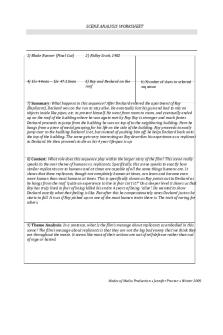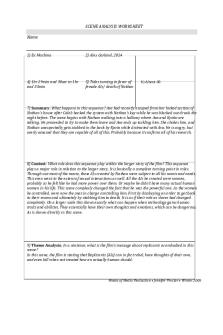Contentless Scene Analysis Fall 2020 PDF

| Title | Contentless Scene Analysis Fall 2020 |
|---|---|
| Author | proton cho |
| Course | Intro to Acting |
| Institution | University of California San Diego |
| Pages | 2 |
| File Size | 71.8 KB |
| File Type | |
| Total Downloads | 65 |
| Total Views | 154 |
Summary
Download Contentless Scene Analysis Fall 2020 PDF
Description
Contentless Scene: Written Scene Analysis *This assignment, including your actual presentation of your scene, counts as 10% of your final grade* *This analysis must be at least 2-3 pages, typed…please spare me any oversized margins, large fonts, etc.* *This analysis is due on the day you present your scene in class; if you don’t have it ready to turn in, you cannot present your scene that day, and your grade will be docked accordingly* *Each partner needs to turn in their own individual scene analysis - while some information should be agreed upon by both partners (Given Circumstances, Relationship, Objective, External Obstacles), some of it should be completed only by you (Tactics/Actions, Internal Obstacles)* *Get detailed with your choices! Make specific, personalized decisions here…The more specific you can get with your answers, the more you enrich the scene work and fulfill the intentions of the exercise*
1. What are the Given Circumstances of the Scene? WHERE is this scene taking place? If it’s happening “on a beach”, for example, then which beach exactly? Have you been to this beach before? Is it in the US or abroad? Is it a public or private beach? Is it close to your home? Is the water usually warm or cold? Is it heavily populated or is it remote? etc. etc. WHEN is this scene taking place? What time of day exactly, i.e. 2 PM or 2 AM? What month/season/year/era? Is it a special occasion, i.e. a birthday or Valentine’s day? etc. etc. WHAT is taking place in the scene? Is it a BBQ? A seemingly average day at the office? A triathlon? etc. etc. Where are your character’s IMMEDIATE CIRCUMSTANCES? What has happened to your character before the scene begins? Have you been studying for the past six hours straight? Did you just get yelled at by your mom? Did you just wake up from a nap? Did you just get a job promotion? etc. etc.
2. What is the Relationship between you and your scene partner? How do these people know each other? How well do they know each other? How long have they known each other? What is their history together? How much, and in what ways, does this relationship impact your character?
3. What does your character Want in this scene from your scene partner, i.e. what is your character’s Objective? Examples: I want them to give me $100. I want them to give me a hug. I want them to leave the room. I want them to respect my authority. I want them to forgive me. I want them to share their lunch with me. I want them to ask me out on a date. I want them to drive me to the mall. I want them to marry me. etc. etc. Note: your character’s Objective should aim to clash with your scene partner’s objective in order to create dramatic Conflict in the scene! Another note: though your Objective might change over the course of a scene, your character will always have one!
4. What Tactics (also known as Actions) will your character use to attempt to achieve their Objective? What will your character do to get what they want? What is your character’s “strategy”, as stated in verb form? List at least four tactics (in verb form) that you, as your character, have already attempted in rehearsal(s), or will attempt to employ during your next rehearsal(s) and/or the presentation. Examples: to flatter your partner, to distract your partner, to horrify your partner, to tease your partner, etc. etc. Note: Choose the most physical and vivid verbs that you can for your character. For example, if your character wants to make your scene partner feel awful about themselves, you might try to flatten them, or stomp them, or demolish them with your character’s lines/behavior.
5. What is an External Obstacle that you could add to escalate the conflict, or “Raise the Stakes”, of your scene? Decide on one with your partner, and try playing the scene with this External Obstacle now included. Examples of External Obstacles: One character’s parents are picking them up in five minutes. The test you are both studying for is not just any test, it’s the freaking LSATs. It was supposed to be a sunny day for this picnic, but it’s just started raining. One character is on crutches. etc. etc.
6. What is a potential Inner Obstacle for your character, i.e. what is one of their Secrets? Avoid sharing this with your partner! Examples of Internal Obstacles: Your character has terrible social anxiety. Your character has always had a little bit of a crush on your scene partner. Your character has never been on a date before. Your character has road rage. Your character still sleeps with their baby blanket, etc. etc.
REHEARSAL SPACE: Rehearsal rooms can be reserved via the computer system in the Main Office located on the second floor of Galbraith Hall. All you need is a UCSD email account to access the schedule. The Office is open Mondays-Fridays, 9AM - 4PM, though it’s closed from 12PM - 1PM for lunch.
FINAL THOUGHTS: -Memorize your lines. Memorize your lines. Memorize your lines. -Set up the rehearsal space to reflect your location in the scene, i.e. design a rough approximation of your set -Bring all necessary props -Wear at least one specific costume item -When you rehearse your scene, always pursue your character’s objective, but try playing the scene as many ways as you can think of! Change up your character’s tactics! Try doing the opposite of what you think your character “should” or “would” do. -HAVE FUN! SURPRISE YOURSELF! PLAY!...
Similar Free PDFs

Ex-Machina Scene Analysis
- 3 Pages

Scene Analysis Worksheet
- 4 Pages

Paper 1 - Scene Analysis
- 4 Pages

Jaws Scene Analysis
- 3 Pages

Scene Analysis - Grade: A
- 6 Pages

Blade Runner Scene Analysis
- 3 Pages

Maleficent Scene Analysis
- 5 Pages

Film Scene Analysis The Insider
- 1 Pages

Fall 2020 transient sheet
- 1 Pages

Fall 2020 Intro Calendar
- 1 Pages

ECO220 syllabus Fall 2020
- 12 Pages
Popular Institutions
- Tinajero National High School - Annex
- Politeknik Caltex Riau
- Yokohama City University
- SGT University
- University of Al-Qadisiyah
- Divine Word College of Vigan
- Techniek College Rotterdam
- Universidade de Santiago
- Universiti Teknologi MARA Cawangan Johor Kampus Pasir Gudang
- Poltekkes Kemenkes Yogyakarta
- Baguio City National High School
- Colegio san marcos
- preparatoria uno
- Centro de Bachillerato Tecnológico Industrial y de Servicios No. 107
- Dalian Maritime University
- Quang Trung Secondary School
- Colegio Tecnológico en Informática
- Corporación Regional de Educación Superior
- Grupo CEDVA
- Dar Al Uloom University
- Centro de Estudios Preuniversitarios de la Universidad Nacional de Ingeniería
- 上智大学
- Aakash International School, Nuna Majara
- San Felipe Neri Catholic School
- Kang Chiao International School - New Taipei City
- Misamis Occidental National High School
- Institución Educativa Escuela Normal Juan Ladrilleros
- Kolehiyo ng Pantukan
- Batanes State College
- Instituto Continental
- Sekolah Menengah Kejuruan Kesehatan Kaltara (Tarakan)
- Colegio de La Inmaculada Concepcion - Cebu




